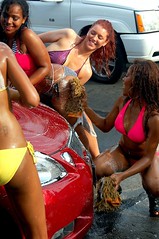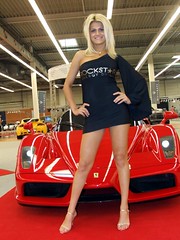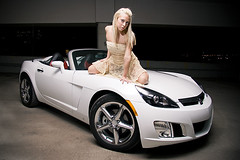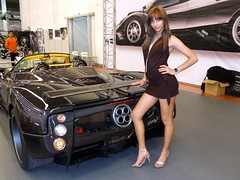By Eric Wilson for The New York Times:
The 90th-anniversary issue of Vogue Paris hit newsstands here this week, just in time for the Paris collections and an elaborate masked ball that Carine Roitfeld, the editor, is planning on Thursday night in a hotel particulier. The theme of the party is “Eyes Wide Shut,” and Ms. Roitfeld expects everyone to look as good as her October cover model, Lara Stone, who appears in a lace mask by Philip Treacy.
Ms. Roitfeld’s new issue set a record for the publication with 620 pages, many of them advertisements created specially for the anniversary, like one by Chanel that consists of a sketch by Karl Lagerfeld that shows the designer standing just behind Coco Chanel herself, her hands stuffed in her skirt pockets. For the magazine’s feature well, Ms. Roitfeld opened each photo portfolio with an archival image, followed by a contemporary take on fashion inspired by the same story. For example, a Horst P. Horst image of a masked ball from 1934 leads into a an erotic fantasy of masked models by Mert Alas and Marcus Piggot. Mario Sorrenti, David Sims, Steven Klein and Hedi Slimane also contributed to the issue.
Perhaps the most controversial story will be Terry Richardson’s images of Crystal Renn, the (not quite) plus-size model who has become a vocal advocate for incorporating different sizes in fashion magazines. Here, she is shown gorging on an endless feast, about to stuff an entire squid into her mouth in one picture, gnawing on beef, sausage and poultry in others. It’s a statement.
Ms. Roitfeld, when I met her in her office, said the shoot was actually inspired by the 1973 movie “La Grande Bouffe,” the dark Marco Ferreri film about a group of men who retire to a villa to eat themselves to death. Ms. Roitfeld said she realized, while looking at the provocative — and sometimes shocking — imagery from Vogue’s past, that it is the job of fashion magazines to continue to push boundaries and provoke, even in the face of attacks on their judgment.
Here are some excerpts from our conversation:
How do you feel about the magazine at 90?
In 90 years, we haven’t changed the mood of the magazine. It’s still very audacious. It’s still about beauty. It’s still about excess. It’s still very avant-garde. When we started to do the research, we discovered the same mood in the past, so we are very happy to feel that we are still looking like the iconic Vogue of Newton and Guy Bourdin. We try to be sophisticated, while a little on the edge all the time. But what I can see is that now, the censoring is bigger than it was 20, 30 or 40 years ago. I think we have less freedom. Today some pictures would not even be publishable. It’s not just about the nudity, but when you talk about things politically, the military, kids, it would all be politically incorrect and not publishable today.
How does that make you feel as an editor?
That we have to fight to keep this un-politically correct attitude of French Vogue, but it’s more and more difficult to be able do that. You cannot smoke, you cannot show arms, you cannot show little girls, because everyone now is very anxious not to have problems with the law. Everything we do now is like walking in high heels on the ice, but we keep trying to do it.
When you explain your philosophy about fashion to anyone who wants to contribute to French Vogue, what is it that you tell them?
Vogue is a very specific world. You are Vogue, or not Vogue. There are some editors and writers who can be very good, and still not Vogue. How can I describe it? It is, first, having the sense of luxury. It’s a sense of craziness, a bit. It’s a sense of beauty, because the images we are printing, most of them are going to be in a museum. It has to be cultural, because I think the French woman is not just interested in fashion. She is interested in painting, reading, movies and art, so it is a lot of things, altogether, to be a Vogue photographer, writer or stylist. And a Vogue reader.
What are you most proud of that you have brought to this magazine in the last 10 years?
When I see this anniversary issue, I think it is the best coffee-table book. I think it is good when something can stay interesting for a long time. It’s not just a trend for one month. What we did in this issue, I hope, in 10 years, will not be démodé, because now everyone can see fashion on the Internet. You can go on Style.com and see everything, but not how to wear it. This is what we try to give to the readers of Vogue.
How do you remain personally engaged with fashion when everyone else can see it online?
It’s still exciting to me, because when I am going to a fashion show, I’m not just looking at the clothes. I’m looking at the mood, I’m listening to the music, so sometimes, I can be a bit disappointed in one, two or three shows, and then I see a great one and my energy goes up again. There were some big fashion moments last week in Italy, like when you go to Prada, and wonder what’s she going to do this time, or at Dolce & Gabbana, and you are almost ready to cry. Maybe I still like the clothes. I don’t see them just to wear them, I see them as a piece of art sometimes.
With all the new designers hoping to be discovered, how do you know when someone really has it?
It is difficult. First, we have to find a moment to look at these young stylists, because we are overbooked with shows, overbooked with appointments and work like everyone else. But we try to find the time, because they are the future of tomorrow. When you talk to them, you know almost instantly. It’s like an instinct when you see a young painter or photographer. Because we have a big power, we have to use it to give an opportunity to some young kids, designers, makeup artists, photographers and models. It’s good that Anna Wintour was the one who needed to kick our butt, in a way, to do something. She did a lot in America, but in Paris, we were a bit slow. Now we understand, and we’ve seen so much return that we are going to be more and more aware to help.
Who do you think among the younger generation has the potential to become big?
I am very surprised by someone like Alexander Wang. I am amazed how he is good with fashion, with business, with public relations himself, with an attitude in his clothes that is spoken immediately. And I think a young guy called Joseph Altuzarra, who went to New York, is the next one to be big. The clothes he makes are very beautiful, and they are very wearable.
What bothers you about fashion today?
Sometimes I think, Why do I have to go to a show? Half an hour driving, half an hour waiting, seeing the show, then half an hour back. And when I get back, I see the show on the Internet. Sometimes it goes too quick sometimes. I like the idea of what Tom Ford did in New York. No one saw one outfit, except the 100 people who were guests. It was smart, because it makes envy. It’s too easy that Prada makes a collection and two hours later its on the Net and everyone can copy it. It’s too quick now, but I don’t think we can do anything about that. It’s just the time.
What’s next for you?
I’m full of ideas, and I want to have more parties and shows for the public. I want to make fashion more festive in Paris. This week we have the Vogue bar at the Crillon, where we changed the décor, the cocktail list, the pictures on the wall. The drinks are named after people. My drink is a Testarossa. It’s Campari and vodka, to fly very high, very far, very quick. We have the dirty martini of Stephen Gan — it’s delicious — and the apple martini of Tom Ford. I have a new job now: bartender. That is my dream, and also to open a karaoke.
What would be your song?
“You’re So Vain.” I think in this business, it’s a good song. It’s dedicated to a lot of people.
skip to main |
skip to sidebar






























Archive
-
▼
2010
(1195)
-
▼
September
(69)
- Q. and A. With Carine Roitfeld
- Balenciaga Spring 2011 Show Video
- October Italian Vogue editorial - Dorothea Barth J...
- Balenciaga Spring 2011 Show
- Roberto Cavalli 40th Anniversary Book - making of ...
- Hakaan Spring 2011 Show
- October 2010 Italian Vogue Cover Preview - Mariaca...
- Jil Sander Spring 2011 Show Video
- Jil Sander Spring 2011 Show
- "Squirrel Seeks Chipmunk" by David Sedaris
- Giles Deacon Spring 2011 Show Video
- Veruschka von Lehndorff Is London’s Top Model
- Gucci Spring 2011 Show Video
- Dolce & Gabbana Spring 2011 Show Video
- Dolce & Gabbana Spring 2011 Show
- The Gap Fall 2010 Campaign - Lais Ribeiro, ph: Cra...
- Versace Spring 2011 Show
- Versace Spring 2011 Show Video
- Karen Elson - "The Truth is in the Dirt" video
- Prada Spring 2011 Show
- Short Japanese Hairstyles for Asian Girls
- Short Japanese Hairstyles for Asian Girls
- Wonderland Sep/Oct 2010 Editorial - Cameron Russel...
- Sportmax Spring 2011
- Homework!
- November 2010 Japanese Vogue editorial: Dorothea B...
- Alberta Ferretti Spring 2011 Show
- Gucci Spring 2011 Show
- Giles Deacon Spring 2011 Show Video
- September 21, 2010
- Burberry Spring 2011
- Jonathan Saunders Spring 2011 Show
- Christopher Kane Spring 2011 Show
- Giles Deacon Spring 2011 Show
- Anna Sui Spring 2011 Show
- Models.com Top 10 Newcomer: Britt Maren
- Ohne Titel Spring 2011 Show
- "Countours" - written and directed by Christina Kruse
- Mark Fast spring 2011 Show
- Topshop Unique Spring 2011 Show
- New Wrist Tattoo Design
- Hairstyle womens-Face Framing Fringe Hairstyle
- Hairstyle womens-Face Framing Fringe Hairstyle
- New Flower Tattoo
- Lotus Flower Tattoo
- New Rose Tattoo
- Marc Jacobs Spring 2011 Show
- Marc Jacobs Spring 2011 Show Video
- Joseph Altuzarra Spring 2011 Show
- Alexander Wang Spring 2011 Show Video
- Alexander Wang Spring 2011 Show
- Female Lower Front Cherry tattoo
- BCBG Spring 2011 Show
- Cushnie et Ochs Spring 2011 Show
- Yves Saint Lauren Cosmetics Fall 2010 Campaign - G...
- W Korea September 2010 Cover: Iris Strubegger, ph:...
- Fashions Night Out The Show: Kasia Struss and Guid...
- New Ana Mihajlovic Polaroids
- New Laura Liriano Polaroids
- Francois Nars Pure Matte Lipstick campaign: Heathe...
- "Iris" - An Exclusive Fashion Film from NOWNESS.com
- Lower Front Cherry Tattoo
- Shoulder Cherry Tattoo
- Anda & Masha by Selima Launch: Wed September 8, 7-9pm
- Behati Prinsloo photo exhibition at Fashion's Nigh...
- "Fashion Week Preview: The Faces" by Cathy Horyn
- Women New York City Spring/Summer 2011 Show Packag...
- Italian Vogue September 2010 preview: Mariacarla B...
- LOVE Magazine fall 2010 editorial preview: Ginta L...
-
▼
September
(69)